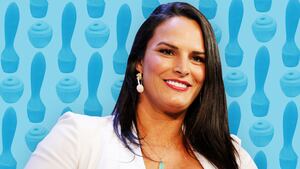Gwyneth Paltrow’s Netflix show The Goop Lab, which premieres Jan. 24, interprets the word laboratory loosely. Setting aside standard requirements like structured experiments and the scientific method, most laboratories, both real and fictional, tend to operate under the assumption that they may well create or discover something new—whether it’s penicillin, a girlfriend, or a robot to do chores. The Goop Lab, on the other hand, repackages exactly what you’ve known, maybe liked, possibly once even paid money for, but probably hated about its namesake site—only now in the form of six half-hour episodes. In truth, The Goop Lab is less like a lab and more like “The goop Lab,” a 1,300-square-foot, immaculately decorated bungalow tucked into the Brentwood Country Mart in Santa Monica, where the company hawks products like “Moon Juice’s Beauty Dust” and $80 linen hand towels. That is to say: an exorbitantly-priced store.
Or more precisely, an infomercial. Six of them! Watching The Goop Lab is like channel-surfing at 3 a.m. and finding back-to-back docutainment, only instead of Bowflexes and George Foreman Grills they’re peddling Paltrow and her empire of stone diffusers and activated charcoal toothbrushes. (The simile works because they’re both trying to sell you stuff, but also because the show is boring). The episodes take a gradual ascent into woowoo, starting first with psychedelics in the pilot (lots of crying), before moving on to cold exposure therapies in the second episode, where a shirtless, beanie-wearing older man, bearing a stark resemblance to Bill Murray in The Life Aquatic with Steve Zissou, explains how regular excursions in freezing water have kept him from ever getting ill.
In the third episode, by far the best, the team attends an orgasm workshop, where they learn about female anatomy, pleasure, and whether their vaginas look weird (answer: no). At one point, in what is sincerely a radical piece of television, the participants scroll through full-size pictures of vulvas, both to illustrate the wide range of options, and probably to beat some kind of record for on-screen snatch. In the fourth episode, by far the worst, Paltrow and her team explore anti-aging regimens, calculating their “biological age,” adopting obscene diets (Paltrow wearily describes eating 500 calories a day), and having hushed discussions about whether they fear aging on their face (only one woman cops to it; the others stare at her agog, as if she just confessed to public defecation or using shampoo with parabens). Articles about this episode frequently comment on Paltrow’s “vampire facial,” where she has plasma from her own blood injected into her face. But far more disturbing, in my view, was the procedure Paltrow’s colleague received, which involved sewing fine metal threads into her cheeks, ostensibly to stimulate collagen, but which also left her with a puckered smile straight out of Joker. Later, after washing off the blood, she shows the Frankenstein scars to her toddler-age son. “Does mommy look scary?” she asks. Yes, she does.
The fifth and sixth episodes are more or less the same, so similar you can feel the producers floundering for material: energy reading (one Goop exec gets an “exorcism”) and psychic readings (they call it “intuiting”). By this point, the show throws any attempt at peer-reviewed legitimacy to the wayside, veering into Bruno Latour-type questions about how far science itself can be trusted, and dropping technical-sounding terms like “quadruple blindfold study”—meaning, I’m not kidding, a study of four people who are blindfolded. The show strains under its attempt at self-awareness, with frequent comments about the accessibility of their lifestyle (“The tenets of wellness are typically free,” one Goop exec exclaims. “It’s true!” Paltrow coos), a staged skeptic for every given exercise (in the end, all are convinced), and occasional hat-tips to the political climate where most people’s major concerns have little to do with intermittent fasting (in the final scene of the show, Paltrow turns to her resident medium-psychic and asks: “Can you tell me who will be president in 2020?”).
Who is this show for? Certainly, some Goop fans will put threads in their faces, drink ayahuasca, and dive into arctic lakes to stave off E. coli. But the show, which treads in territory familiar to any casual visitor to their website, feels as much for Goop’s critics as its readers—as was obvious the minute Netflix dropped the poster, featuring Paltrow, Stepford Wife-smiling in a pink wrap dress, Photoshopped into an animated fuchsia vagina. It nods both to the show’s third episode and to Goop’s most notorious scandal—in which the website was sued for making faulty claims that a $66 “jade vaginal egg,” meant to be inserted into the birth canal, could prevent uterine prolapse. The company had to pay out $145,000 in penalties and change their marketing claims, but continued to sell the product for long after. The incident became a symbol both of Goop’s egregious disregard for peer-reviewed studies, and of their martyrdom among die-hard fans, convinced scientific hubris has prevented people from trying new treatments. There was something quasi-Trumpian about the poster: We know what you think of us, it seemed to say, and we don’t really care.
Goop does care though. In Taffy Brodesser-Akner’s definitive profile of Paltrow in The New York Times Magazine, she describes a day when several Harvard students questioned the actress about charges of elitism and faulty science, leading to flares of intense public scrutiny—moments which Paltrow calls “cultural firestorms.” Goop had mastered a specific skill, Akner explained: “corral[ling] the vitriol of the internet and the ever-present shall we call it cultural ambivalence about G.P. herself and turn them into cash.” Or as Paltrow put it: “I can monetize those eyeballs.”
The Goop Lab is all about monetizing eyeballs. Unfortunately, it’s also predictable and dull. Monetize your eyes elsewhere! It may not cure uterine prolapse, but it’s probably more fun.


